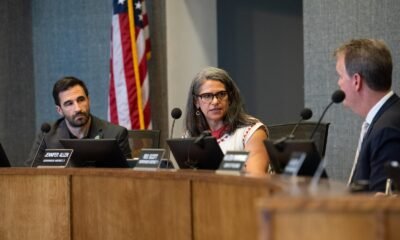Business
Federal Reserve’s Powell Hints at Potential Interest Rate Cut on the Horizon

Former President Donald Trump has said the Fed shouldn’t cut rates before the election.
WASHINGTON — Federal Reserve Chair Jerome Powell on Wednesday prepared the groundwork for what could be the central bank’s first rate cut in four years. Powell cited significant progress in reducing inflation and a job market that is no longer overheating.
Despite some calls from economists and Democratic politicians for a swift rate cut, the Fed held its key interest rate steady at a 23-year high of 5.3%. Powell indicated that if inflation trends continue downward, a policy rate reduction could be considered during the Fed’s next meeting on September 17-18.
“We’re getting closer to the point at which it’ll be appropriate to reduce our policy rate,” Powell said, “but we’re not quite at that point.”
A rate cut, although expected by financial markets, won’t have an immediate impact but could over time lower borrowing costs for consumers and businesses, influencing mortgage and auto-loan rates. It could also support the economy and potentially boost Vice President Kamala Harris’ chances in the upcoming presidential election. Former President Trump, however, has argued against rate cuts before the election.
In a Wednesday statement, the Fed noted “job gains have moderated” and acknowledged the rising unemployment rate. Required by Congress to ensure stable prices and maximum employment, the central bank is “attentive to the risks” to both objectives.
This focus on both inflation and employment marks a significant shift from years of prioritizing inflation control. Powell stated the Fed is ready to cut rates, barring any inflation surprises before September.
Financial markets had confidently predicted a rate cut in September, and stocks saw gains after the Fed’s announcement. The S&P 500 ended Wednesday up 1.6%.
The Fed aims to maintain a balance: keeping rates high enough to curb inflation, which has dropped to 2.5% from a peak of 7.1%, but not so high as to trigger a recession. Powell described the economy as being in a “sweet spot,” with stable inflation and solid hiring, while wage growth has cooled, reducing inflationary pressure.
“It’s neither an overheating economy nor is it a sharply weakening economy,” Powell said.
The Employment Cost Index showed slower wage growth in the second quarter, aligning with inflation rates. Powell emphasized this trend is what the Fed wants to see, although rising unemployment has prompted some economists to advocate for faster rate cuts.
On Monday, Bharat Ramamurti of the American Economic Liberties Project urged the Fed to cut rates quickly to avoid economic pitfalls. Meanwhile, Senator Elizabeth Warren and two other Democratic senators also pressed Powell to reduce rates, suggesting inaction would appear politically motivated.
Powell asserted that elections would not influence the Fed’s decisions. “We don’t change anything in our approach to address other factors like the political calendar,” he said.
Recent data shows yearly inflation fell to 2.5% in July, the lowest since February 2021, while the unemployment rate has risen to 4.1% and hiring has slowed. The Fed’s next moves are watched closely as the global economic landscape shifts, with central banks in Europe and Japan also adjusting their monetary policies.


















